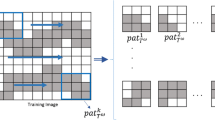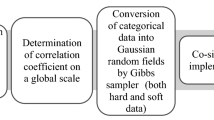Abstract
The reproduction of the non-stationary distribution and detailed characteristics of geological bodies is the main difficulty of reservoir modeling. Recently developed multiple-point geostatistics can represent a stationary geological body more effectively than traditional methods. When restricted to a stationary hypothesis, multiple-point geostatistical methods cannot simulate a non-stationary geological body effectively, especially when using non-stationary training images (TIs). According to geologic principles, the non-stationary distribution of geological bodies is controlled by a sedimentary model. Therefore, in this paper, we propose auxiliary variables based on the sedimentary model, namely geological vector information (GVI). GVI can characterize the non-stationary distribution of TIs and simulation domains before sequential simulation, and the precision of data event statistics will be enhanced by the sequential simulation’s data event search area limitations under the guidance of GVI. Consequently, the reproduction of non-stationary geological bodies will be improved. The key features of this method are as follows: (1) obtain TIs and geological vector information for simulated areas restricted by sedimentary models; (2) truncate TIs into a number of sub-TIs using a set of cut-off values such that each sub-TI is stationary and the adjacent sub-TIs have a certain similarity; (3) truncate the simulation domain into a number of sub-regions with the same cut-off values used in TI truncation, so that each sub-region corresponds to a number of sub-TIs; (4) use an improved method to scan the TI or TIs and construct a single search tree to restore replicates of data events located in different sub-TIs; and (5) use an improved conditional probability distribution function to perform sequential simulation. A FORTRAN program is implemented based on the SNESIM.

















Similar content being viewed by others
References
Arpat GB, Caers J (2007) Conditional simulation with patterns. Math Geol 39(2):177–203
Boisvert JB, Manchuk JG, Deutsch CV (2009) Kriging in the presence of locally varying anisotropy using non-Euclidean distances. Math Geosci 41(5):585–601
Boucher A (2009) Considering complex training images with search tree partitioning. Comput Geosci 35(6):1151--1158
Caers J, Zhang T (2004) Multiple-point geostatistics: a quantitative vehicle for integrating geologic analogs into multiple reservoir models. In: Grammer GM, Harris PM, Eberli GP (eds) Integration of outcrop and modern analog data in reservoir models, AAPG memoir 80. American Association of Petroleum Geologists, Tulsa, OK
Chugunova TL, Hu L (2008) Multiple-point simulations constrained by continuous auxiliary data. Math Geosci 40(2):133–146
Comunian A, Renard P, Straubhaar J, et al. (2011) Three-dimensional high resolution fluvio-glacial aquifer analog–part 2: geostatistical modeling. J Hydrol 405(1):10–23
de Vries LM, Carrera J, Falivene O, et al. (2009) Application of multiple point geostatistics to non-stationary images. Math Geosci 41(1):29–42
Hashemi S, Javaherian A, Ataee-pour M, et al. (2014) Two-point versus multiple-point geostatistics: the ability of geostatistical methods to capture complex geobodies and their facies associations—an application to a channelized carbonate reservoir, southwest Iran. J Geophys Eng 11(6)
Honarkhah M, Caers J (2012) Direct pattern-based simulation of non-stationary geostatistical models. Math Geosci 44(6):651–672
Hu L, Liu Y, Scheepens C, et al. (2014) Multiple-point simulation with an existing reservoir model as training image. Math Geosci 46(2):227–240
Huysmans M, Dassargues A (2009) Application of multiple-point geostatistics on modelling groundwater flow and transport in a cross-bedded aquifer (Belgium). Hydrogeol J 17(8):1901–1911
Huysmans M, Orban P, Cochet E, et al. (2014) Using multiple-point geostatistics for tracer test modeling in a clay-drape environment with spatially variable conductivity and sorption coefficient. Math Geosci 46(5):519–537
Jiao Y, Yan J, Li S, et al. (2005) Architectural units and heterogeneity of channel reservoirs in the Karamay formation, outcrop area of Karamay oil field, Junggar basin, northwest China. AAPG Bull 89(4):529–545
Liu Y (2006) Using the Snesim program for multiple-point statistical simulation. Comput Geosci 32(10):1544–1563
Lopez S, Cojan I, Rivoirard J, et al. (2009) Process-based stochastic modelling: meandering channelized reservoirs. In: Analogue and Numerical Modelling of Sedimentary Systems: From Understanding to Prediction, Special publication 40 of IAS
Mariethoz G, Renard P (2010a) Reconstruction of incomplete data sets or images using direct sampling. Math Geosci 42(3):245–268
Mariethoz G, Renard P, Straubhaar J (2010b) The direct sampling method to perform multiple-point geostatistical simulations. Water Resour Res 46(11)
Mariethoz G, Kelly BFJ (2011) Modeling complex geological structures with elementary training images and transform-invariant distances. Water Resour Res 47(7)
Mariethoz G, Caers J (2014) Nonstationary modeling with training images. In: Multiple-point geostatistics: stochastic modeling with training images. Wiley, New York
Miller J, Sun T, Li H, et al. (2008) Direct modeling of reservoirs through forward process based models: Can we get there?. International Petroleum Technology Conference PETRONAS, Kuala Lumpur 3–5
Pyrcz M J, Strebelle S. (2006) Event-based geostatistical modeling: application to deep-water systems. Reservoir characterization: integrating technology and business practices, Gulf Coast Section, SEPM Twenty-sixth Annual Research Conference, pp 893–922
Rezaee H, Mariethoz G, Koneshloo M, et al. (2013) Multiple-point geostatistical simulation using the bunch-pasting direct sampling method. Comput Geosci 54:293–308
Rezaee H, Asghari O, Koneshloo M, et al. (2014) Multiple-point geostatistical simulation of dykes: application at Sungun porphyry copper system, Iran. Stoch Env Res Risk A 28(7):1913–1927
Straubhaar J, Renard P, Mariethoz G, et al. (2011) An improved parallel multiple-point algorithm using a list approach. Math Geosci 43(3):305–328
Strebelle S (2002) Conditional simulation of complex geological structures using multiple-point statistics. Math Geol 34(1):1–21
Strebelle S, Zhang T (2005) Non-stationary multiple-point geostatistical models. Geostatistics Banff 2004. Springer, Dordrecht, pp. 235–244
Vargas-Guzmán JA (2008) Transitive geostatistics for stepwise modeling across boundaries between rock regions. Math Geosci 40(8):861–873
Vargas-Guzmán JA (2011) The Kappa model of probability and higher-order rock sequences. Comput Geosci 15(4):661–671
Vargas-Guzmán JA (2014) Unified principles for nonlinear nonstationary random fields in stochastic geosciences. In: Mathematics of planet earth. Springer, Berlin Heidelberg, pp. 857–861
Wu J, Boucher A, Zhang T (2008) A SGeMS code for pattern simulation of continuous and categorical variables: FILTERSIM. Comput Geosci 34(12):1863–1876
Acknowledgments
This study is supported by both of the National Planned Major Science and Technology Projects of China (No. 2011ZX05009-003) and the National Natural Science Foundation of China (No. 41372116). We thank our colleagues, Senlin Yin, Zhen Li, Mei Huang, and Yafei Jing for their help on the data analysis and program debugging.
Author information
Authors and Affiliations
Corresponding author
Rights and permissions
About this article
Cite this article
Feng, W., Wu, S. A multiple-point geostatistical method based on geological vector information. Arab J Geosci 9, 562 (2016). https://doi.org/10.1007/s12517-016-2595-3
Received:
Accepted:
Published:
DOI: https://doi.org/10.1007/s12517-016-2595-3




